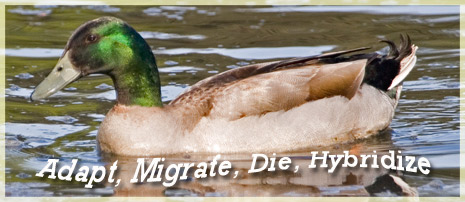
Well after a week of battling a hosting issue, I am finally back online and able to access my account. However, I think the headache will be worth it as the updates made to JournOwl.com will increase site usability, especially enabling visitor comments that I hope will spur discussion and continue to link ecologically minded individuals.
Now getting back to the hybridization question I started a few weeks back, I wanted to explore the role it has as an evolutionary tool. Interspecific hybridization has been described as a window into the evolutionary process because they [hybrids] are a culmination of genetic material from previously isolated gene pools. Publications routinely recognize the importance of hybridization and introgression in the plant community, but as it turns out the implications in animal species is less defined.
With the reduction of natural barriers and wildlife population numbers, I wonder if we are on the verge of witnessing an increase in the interaction of species that at one time practiced genetic separation. I’ve already mentioned some newsworthy specimens such as blue/fin whale and polar/grizzly bear hybrids in the previous post, and there are many more especially in fish of the U.S. Southwest, but where do these genetic middlemen fit in as far as diversification and evolution?
Typically speaking, hybrids have a combination of genes that have not withstood the test of time and as such have not been evolutionarily fine-tuned. Thus, hybrid individuals often display biological differences like faster or slower growth and reproductive inefficiencies, behavioral proclivities that make it difficult to find mates, and physiological traits that may increase predation. Because of the repercussions, hybridization usually finds itself as a dead end, but not always.
There have definitely been successful species produced as a result of hybridization, and perhaps as habitats continue to undergo rapid changes and populations diminish sharply we will encounter more and more hybrids that have suddenly become ecologically efficient and filling new niches. After all, species are not in a position to wait for gene combinations to be fined-tuned through evolution. Maybe it is time to update the age old species adage “Adapt, Migrate, Die” and add Hybridize as a fourth option.
According to J. Mallet in 2005, “Phylogenetic hotspots, where approximately 25% of animal species hybridize, include British duck and game bird species, and American warblers and butterflies, but overall, 6–12% of bird, butterfly, and mammal species hybridize naturally.”
Not quite as exciting to the average person as hybrid mammals, a recent study has provided evidence that hybridization amongst corals has contributed to reef diversity and resilience, and has been “instrumental in their diversification on evolutionary timescales. Evidence that coral hybrids colonize marginal habitats distinct from those of parental species’ and that hybridization may be more frequent at peripheral boundaries of species’ ranges supports a role for hybridization in range expansion and adaptation to changing environments. We conclude that outcomes of hybridization are significant for the future resilience of reef corals and warrant inclusion in conservation strategies (Willis, BL. 2006. The role of hybridization in the evolution of reef corals. Annu. Rev. Ecol. Evol. Syst. 37:489–517).”
Picture: Mallard Hybrid, FWS (2006)


Very interesting subject area. I’m always fascinated by the variety of mallard hybrids that we see in our local area. I’ll come back and read more of youir articles later. (I’ve only just found your blog, via Best Green Blogs).
Thanks for the note. I actually took care of an injured hybrid mallard during an internship at a wildlife hospital…of which became rather tame as it was unable to be released into the wild.
I also just found this blog through Best Green Blogs. I thought your article was excellent and got me thinking. Look to hear more from you and on twitter.
Thanks for the comment as I definitely strive to get people thinking. I too look forward to your tweets and latest posts on Complimedia.